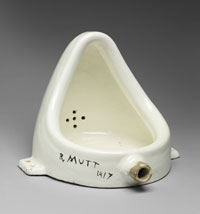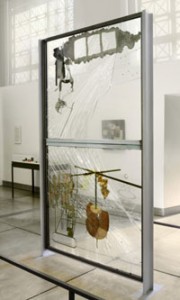Introduction
This essay will try to formulate a coherent statement about the connection between two influential ‘conceptual event-objects’ created by the French avant-garde painter and conceptual artist Marcel Duchamp (1887-1968). The two items under discussion are Fountain (1917; Fig. 1) and Large Glass (1913-1925; Fig. 2).
Maybe to call them provisionally ‘conceptual event-objects’ might be helpful in order to ween us away from our conventional manner of conceptualizing. Admittedly, these objects are now treated as art objects, with their reproductions now statically displayed in various museums, but, after reading about them, they also have serious temporal aspects to justify the term of ‘event’ and are also highly conceptual in their referral to philosophical questions regarding the ontological status of art and its relation to reality, even the nature of reality itself. In other words, all conventional meanings associated with art and art production are more or less suspended to facilitate, at least for me in my historical situatedness, a fresh entry into the subject.
Note on Method
The terms and ideas which seem to be often associated with both objects, both in the writings of Duchamp himself and in the writings by commentators are: esthetics; taste; readymade; indifference; object; event; mind; humor; irony; meta-irony; sarcasm; delay; timing; subversion; inversion; functionality; and science.
One manner of bringing these terms together in their coherence is by using them in one paragraph, or ideally in one sentence, and by this limitation of space force the inner structure of their connections to come out by a creative use of grammar and connecting words. And if in the process the form of the linguistic accomplishment reflects its content, then maybe a truly coherent ‘statement’ might be had. Therefore, without further ado:
Duchamp’s readymades are humorous, ironic, sometimes even sarcastic subversions of both traditional and avant-garde standards of taste and esthetics of the late Belle Époque, by choosing esthetically neutral objects to which he felt indifferent, giving them thought-provoking titles which invert the locus of action from the object to the mind; from its functionality to its dubious esthetics; from its superficial, narrow, specific quotidian meaning to an open-ended philosophical impact.
Hofmann’s Formalizable Take on Readymades
The above can be construed as another step in opening up this new space in understanding Duchamp, which initially started for me with naive amusement and intrigue and then moved in a formalized framework of understanding readymades with the help of German historian of art Werner Hofmann. In his article “Marcel Duchamp and Emblematic Realism” the author makes the case that Duchamp’s readymades carry a plurality of meaning, or “levels of reality” of which he gives five–and as we shall see, five very logically interconnected–variations.
The first alternate meaning he observes besides its quotidian one, is that readymades indicate that quotidian objects can be more than just their utility and that Duchamp gave ordinary objects an extra aura or authority of meaning. The second interpretation is that a readymade can trigger a “psychopathlogical encounter” with nihilism in the sense that the object has lost all intrinsic esthetic or functional meaning and became completely “enigmatic and unfathomable”. The third variation is that the object can be freed from its functional meaning and seen purely formally and esthetically. The last interpretation is to let “the formal value of the object coincide with the its utilitarian value” (Hofmann in Masbeck; 1975, pp. 62-3).
The formal-logical interconnection of these five meanings can be shown to be as follows. Let B stand for beauty or esthetic value; and let F stand for function or utilitarian value; then the four positions can be formalized as follows:
1) just F ( F & – B )
2) Not only F ( F & X )
3) Not F, nor B ( – F & – B )
4) Not F, but B. ( – F & B )
5) Both F and B ( F & B )
This formalization pretty much exhausts most, if not all, possible combinations of the object’s properties of functionality and esthetics. Though this formalization can give a handle on the enigmatic logic of the multi-interpretable readymade, it is also very abstract, actually, too abstract. What is of course not mentioned are the very specific, complex, historical circumstances in which the readymade emerged, especially in the case of Fountain if we follow the narrative reconstructed by Canadian doctoral candidate in history of art Menno Hubregtse.
Fountain
Hubregtse’s hypothesis is that Duchamp chose the readymade Fountain to both playfully mock and seriously protest a concept of art promoted by an American dealer of avant-garde art, Robert Coady, as an opportunity to challenge the concept of art and the status of the artist in general. Coady, in his magazine The Soil, criticized the influence of European art on American sensibilities and thought that America already had its indigenous, though unintentional, art in the form of its industrial machines and mass products. Hubregtse wrote that “Coady believed that industrial products embodied the spirit of America and had far greater significance as a national art form than the art being produced and promoted by artists and critics trained at the various academies throughout America” (Hubregtse; 2009, p. 29). From several references and other indirect connections between Coady and Duchamp, Hubregtse’s hypothesis of an antagonistic Coady-Duchamp relationship as a background narrative to Fountain looks very plausible.
But it is not the whole story. Hubregtse makes the case that Duchamp was not just opposed to Coady’s concept of American art, but also was looking for an opportunity to challenge any and all standards of esthetics and taste. This was motivated by his anarchist-individualist worldview shaped by his reading of German anarchist philosopher Max Stirner. Hubregtse states that Duchamp’s “submission of the urinal as an art object tried to kick out the pedestal from under the ‘artist’ and destabilize the elevated status the artist enjoyed in the social hierarchy” (Hubregtse; 2009, p. 36).
Large Glass
Moving from Fountain to Large Glass is initially a bit of a challenge. Not everything applicable to readymades could be applied to Large Glass, which on face value looks like a ‘traditional’, ‘conventional’ (from the perspective of the 21st century) piece of modern art with its ‘seemingly abstract, enigmatic content, use of various materials and its reputation as an important milestone in the history of modern art made by the very influential Marcel Duchamp’. But, once the object came out of hiding; and Duchamp’s notes about it were piece by piece published; and the artist himself made some public comments; and friends an experts formulated their interpretations; the item (or conceptual event-object) took on increasingly clear and profound interpretations.
Duchamp’s friend Michel Sanouillet in his introduction to The Writings of Marcel Duchamp basically sees Large Glass as something of a work of science fiction in which the problem of the relationship between man and machine is highlighted in a particular hypothetical scenario, in this case the romantic and sexual relationship between the sexes, but then as machines. Maybe machines are more alive then we think, which opens the possibility that, posed in a question, “What if the machine, stripped of all its anthropomorphic attributes were to evolve in a world made in its image with no reference to the criteria governing man, its creator? (Sanouillet; 1973, p. 8). What would the mental state be, and the laws governing, its possible desires for, and interactions with, other machines? Would there be love, marriage and ‘blossomings’? And if so, how would that look like? Maybe Large Glass is a fantastic depiction of such a science fictional state of affairs in which a mechanical bride excites a bunch of mechanical bachelors and gets excited by them with “essence d’amour” (“love gasoline”), all by the laws (some real, some invented) of mechanical causation and random chance which rule the behavior of cylinders, magnets, weights, pumps, grinders, shootings, etc.
Both Compared
If one would now compare Duchamp’s readymades with Large Glass, it looks like that Large Glass is seemingly a more traditional piece of art, because it has multiple, philosophical messages, though the temporal aspect of it being unfinished and the role of the piecemeal published notes and remarks, makes the object into what I keep calling a conceptual event-object. The object triggers a meaningful event which has to be conceptually finished in the mind. The readymade Fountain is in a similar manner an event which message has to be finished in the mind. Fountain is actually even more of an event, because of the very ephemeral status of its original object. It does not exist anymore, it was never properly exhibited, and might even have been nonchalantly tossed away after it had triggered the event of its higher, ironic, conceptual meaning as a fundamental challenge to the ontological status of art, artists and ordinary objects.
Illustrations
Fig. 1. Duchamp, Marcel. Fountain. 1917.
Fig. 2. Duchamp, Marcel. The Bride Stripped Bare by
Her Bachelors, Even (The Large Glass). 1913-1925.
Philadelphia Museum of Art
Sources
Duchamp, Marcel. The Writings of Marcel Duchamp. Michel Sanouillet and Elmer Peterson (Eds.). N.p.: Da Capo Press, n.d. Print. Originally published by Oxford University Press, 1973.
Hofmann, Werner. “Marcel Duchamp and Emblematic Realism”. In Masbeck, Joseph (Ed.). Marcel Duchamp in Perspective. Englewood Cliffs, NY: Pretice-Hall, 1975. Print.
Hubregtse, Menno. “Robert J. Coady’s The Soil and Marcel Duchamp’s Fountain: Taste, Nationalism, Capitalism, and New York Dada“. Revue d’art canadienne / Canadian Art Review 34 / 2 (2009). Web. 09 Feb. 2014.


